
Aventine Hill in Rome: A Complete Guide to Visiting Monte Aventino (History, Access, Top Things to See & Do)
If you’re looking for a quiet, authentic, and slightly hidden corner of Rome, far from the crowds at the Colosseum and the Trevi Fountain? Then you’re going to fall in love with Aventine Hill in Rome. It’s one of the city’s legendary Seven Hills… and easily one of the most peaceful.
Up here, there’s no rush, no noise, and no endless queues. Instead, you’ll find fragrant gardens, elegant residential streets, ancient churches, and some of the most beautiful panoramic Rome views in the entire city.
The Aventine rises gently above the River Tiber, just beside the Circus Maximus, and it’s a favorite spot for Romans who come here to stroll at sunset. It’s also home to two of the most unique places in Rome: the Orange Garden, with its unforgettable viewpoint, and the famous Aventine Keyhole, a tiny peephole framing one of the most iconic views of St. Peter’s Dome.
In this guide, I’ll walk you through everything you need to know to visit Mount Aventine: its fascinating history, the highlights you shouldn’t miss, the gardens and churches worth seeing, the best places nearby, and plenty of tips to help you enjoy this quiet, enchanting hill to the fullest. Whether you have 30 minutes or half a day, the Aventine offers a peaceful escape with some of Rome’s most breathtaking views.
Ready to explore one of the city’s most charming and secret spots? Let’s make our way up Aventine Hill.
Contents
- 1 What to See and Do on Aventine Hill in Rome
- 2 What to See at the Foot of Aventine Hill
- 3 Views from Aventine Hill: The Most Beautiful Panoramas
- 4 Practical Information for Visiting Aventine Hill in Rome
- 5 Where to Eat and Have a Drink Near Aventine Hill
- 6 A Brief History of Aventine Hill
- 7 What to See Near Aventine Hill
- 8 FAQ About the Aventine Hill in Rome
What to See and Do on Aventine Hill in Rome
Aventine Hill in Rome is a peaceful mix of gardens, ancient churches, panoramic views, and small hidden gems in Rome that give this neighborhood its quiet charm.
Nothing here is massive, nothing feels overtly “touristy”… yet everything is memorable. Here are the places you absolutely shouldn’t miss.
The Orange Garden (Giardino degli Aranci)
You simply can’t talk about Aventine Hill without mentioning the Orange Garden, also known as Parco Savello. It’s one of the most romantic spots in the entire city. If you want to see Rome at its most beautiful, this is where you come.
This small rectangular garden is filled with orange trees that release a delicate fragrance, especially in winter. Legend has it that the very first orange tree was planted here by Saint Dominic in 1220. Whether the story is true or not, the atmosphere is enchanting. The trees, the quiet paths, the view… everything works together to create a moment that feels suspended in time.
From the Orange Garden’s terrace, you can admire:
- the dome of St. Peter’s Basilica
- the Tiber winding below
- the warm terracotta rooftops of Trastevere
- the white marble Altar of the Fatherland monument
- and on clear days, even the distant hills of Lazio
Best time to visit
Come at sunset, when the sky turns pink and the whole city glows in golden light. It’s one of the best photography spots in Rome, and an unforgettable place to pause for a moment.
Practical information
- Address: Piazza Pietro d’Illiria
- Hours: 7 am–6 pm in winter, open until 9 pm in summer
- Entrance: Free
Tip : Right next door, you’ll also find Santa Sabina, one of the most beautiful early Christian churches in Rome, definitely worth a quiet visit.

The Famous Aventine Keyhole
This is probably one of the most famous “secret spots” in Rome, the kind everyone somehow knows about, yet it still manages to surprise every visitor: the Aventine Keyhole, also called the Buco di Roma.
You’ll find it on Piazza dei Cavalieri di Malta, on a large green wooden door belonging to the Villa del Priorato di Malta, the headquarters of the Sovereign Military Order of Malta. The door itself looks completely ordinary… but lean in, place your eye against the keyhole, and get ready to smile.
Through this tiny, perfectly aligned opening, you’ll see:
- a perfectly symmetrical garden path
- carefully trimmed hedges framing the view
- and at the very end, the glowing dome of St. Peter’s Basilica, centered as if by magic
The alignment is so perfect that it almost feels staged… yet the path, the gate, and the basilica belong to three different countries:
- Vatican City
- Italy
- the Sovereign Military Order of Malta
When to visit (and how to avoid the queue)
The Aventine Keyhole is extremely popular, and a small line forms throughout the day. The best moments to go are:
- before 10 am, when the hill is quiet and almost empty
- late afternoon, when the soft light makes St. Peter’s dome stand out even more
Try to avoid early evenings in high season — the wait can easily reach 15 to 20 minutes.
Practical information
- Address: Piazza dei Cavalieri di Malta
- Access: always open; the gate is visible 24/7
- Price: Free

Santa Sabina Basilica
Right next to the Orange Garden, Santa Sabina is a true Early Christian gem, one of the oldest churches in Rome, dating back to the 5th century. Unlike many Roman churches that were transformed during the Baroque period, this one has kept its incredible simplicity.
Inside, you’ll find:
- a luminous nave supported by Corinthian marble columns
- a geometric marble floor
- a 20th-century coffered ceiling that blends in perfectly
- and most impressively… a 5th-century wooden door, miraculously preserved
On this ancient door, you can see 18 carved panels depicting biblical scenes. One of them is particularly surprising: the head of Pharaoh has been replaced with… Napoleon. Yes, Romans do have their own sense of humor.
The adjoining cloister is also said to contain an orange tree descended from the famous fruit planted by Saint Dominic. You can glimpse part of it through a tiny opening in the wall, yet another charming detail that makes Santa Sabina so special.
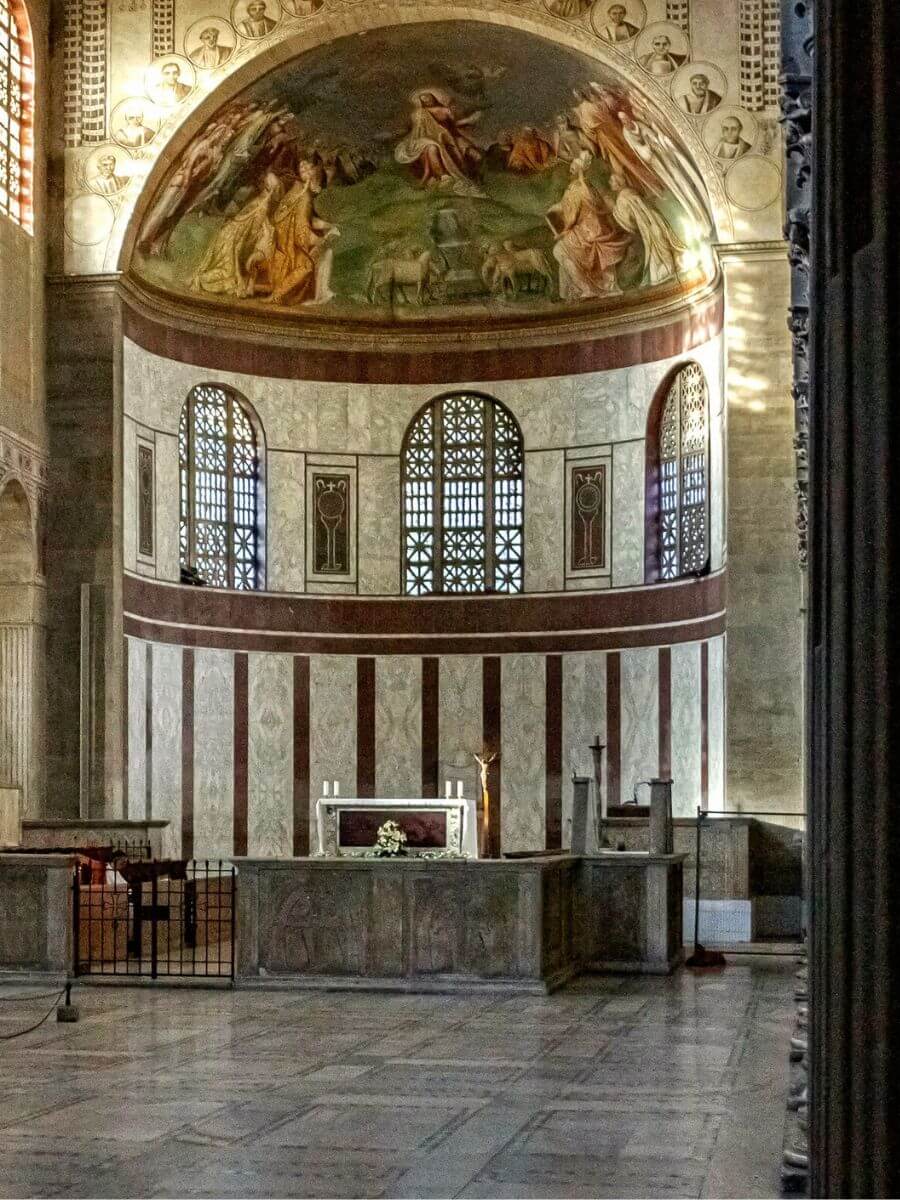
Basilica of Saints Boniface and Alexis (Sant’Alessio)
Just a few steps from Piazza dei Cavalieri di Malta, you’ll find the Basilica of Sant’Alessio, easily recognizable thanks to its Romanesque bell tower. The current church dates largely from the 18th century, but its origins go much further back.
One of the most curious features of the basilica is the wooden staircase kept inside one of the chapels. According to tradition, Saint Alexis slept on this staircase for years after returning from a pilgrimage, without his own parents recognizing him.
It’s a slightly sad yet fascinating story, and it adds to the quiet charm of this often-empty church.

Church of Santa Prisca
As you walk down the slope of Aventine Hill, you’ll come across Santa Prisca, a small, lesser-known church with very ancient origins. It was built over a Christian domus from the earliest centuries of Rome.
The church has been renovated several times, especially in the 17th century, yet it still preserves beautiful Florentine frescoes in both the nave and the apse.
It’s not the most spectacular church in Rome, but it has that quiet, understated charm that makes the Aventine so special, silence, cool air, shade… perfect if you’re looking for a peaceful pause away from the city noise.

The Rome Rose Garden (Roseto Comunale)
At the foot of Aventine Hill, many visitors begin their ascent by passing through the Rome Rose Garden, one of the most colorful green spaces in the city. Here, you’ll find over 1,000 varieties of roses from all over the world.
But the site has a powerful history too: from 1645 to 1934, this very spot was Rome’s Jewish cemetery. To honor that past, the garden’s pathways were designed in the shape of a menorah, the sacred seven-branched candelabrum. It’s a beautiful way of blending nature, culture, and memory.
Best time to visit
The Rose Garden is not open all year, which often surprises visitors. To enjoy the full bloom and fragrance, you need to come between:
- May and October (peak flowering in May and early June)
Outside this period, the gates remain closed.
Practical information
- Address: Via di Valle Murcia
- Hours: vary by season (generally 8:30 am–7:30 pm from May to October)
- Entrance: Free
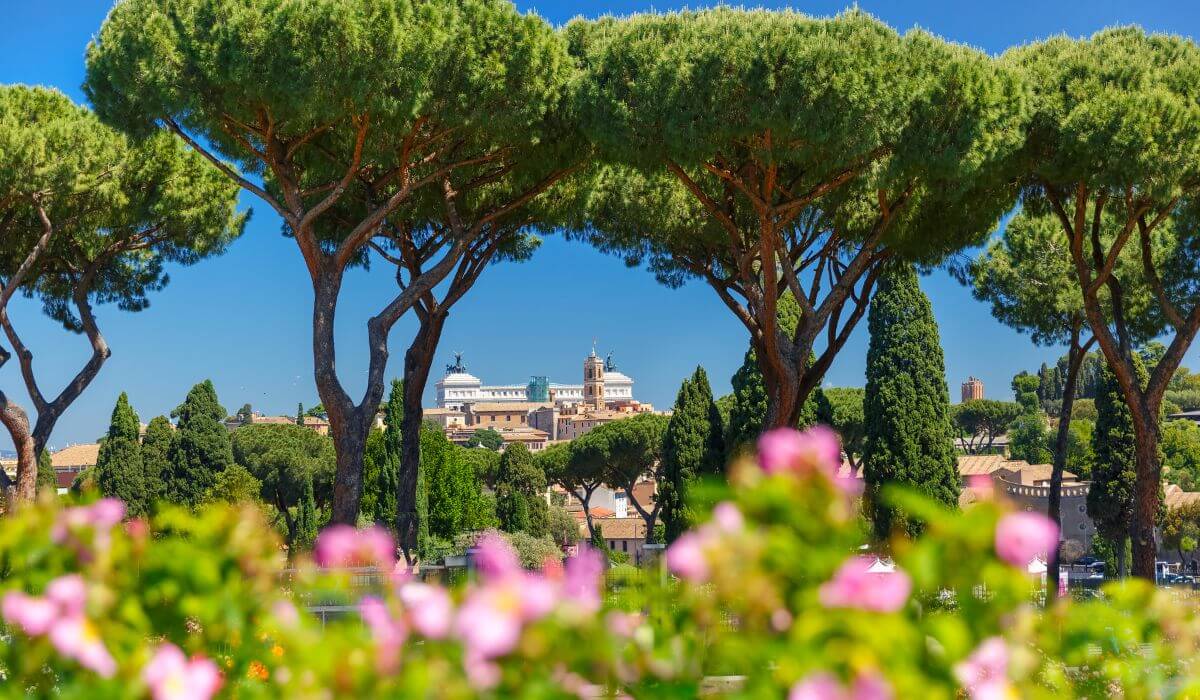
What to See at the Foot of Aventine Hill
As you walk back down from Aventine Hill, the atmosphere changes completely. You leave behind the orange trees, the ancient churches, and the quiet streets, and suddenly Rome becomes more raw, more mysterious, sometimes even a little unexpected.
Here are the places you absolutely shouldn’t miss.
The Non-Catholic (Protestant) Cemetery of Rome
Just below the hill, near Piramide metro station, lies one of Rome’s most poetic places: the Protestant Cemetery, also known as the Non-Catholic Cemetery. It’s a timeless spot, peaceful, romantic, and filled with history.
The cemetery was created to welcome foreign non-Catholics: Protestants, Jews, Orthodox Christians, and those with no religious affiliation. Many artists, writers, and travelers found their final resting place here, including the famous poets John Keats and Percy Shelley.
As you wander through the alleys, you’ll see:
- beautifully carved gravestones, some covered in moss
- towering cypress trees
- lush vegetation that makes the place feel like a secret garden
- and a large community of cats cared for by a local association
The atmosphere is unique. It doesn’t feel like a cold cemetery at all, but rather a gentle, contemplative place where visitors walk in silence, as if exploring an open-air museum. If you love quiet, reflective, slightly melancholic places, you’ll enjoy getting lost here for a few moments.
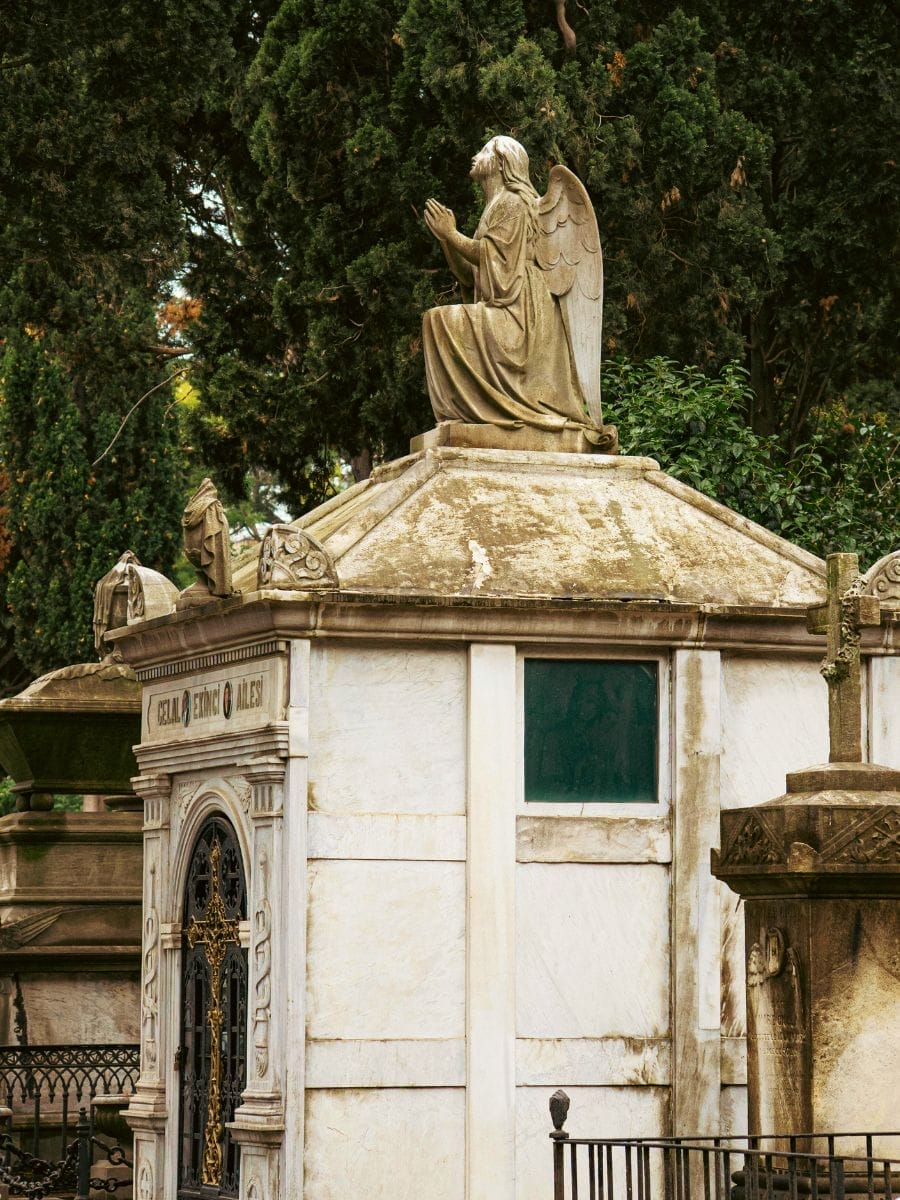
The Pyramid of Cestius
Yes, you read that correctly. Right next to the cemetery stands a real Egyptian-style pyramid. Rome is full of surprises, and the Pyramid of Cestius is one of the most astonishing.
Built in just 330 days, the pyramid dates back to the 1st century BC and served as the tomb of Caius Cestius Epulo, a Roman magistrate fascinated by Egypt. At the time, Egyptian architecture was incredibly fashionable in Rome, just think of the obelisks on Piazza del Popolo or in front of the Pantheon.
The pyramid rises 36 meters high and is remarkably well preserved because it was incorporated into the Aurelian Walls in the 3rd century, which protected it from weather and looting.
Right behind it, you can easily walk into the lively neighborhood of Testaccio, one of Rome’s best areas for food and nightlife. It’s the perfect way to end your visit to the Aventine: a bit of history, a touch of mystery… and then a good glass of wine or a plate of fresh pasta in a real local district.
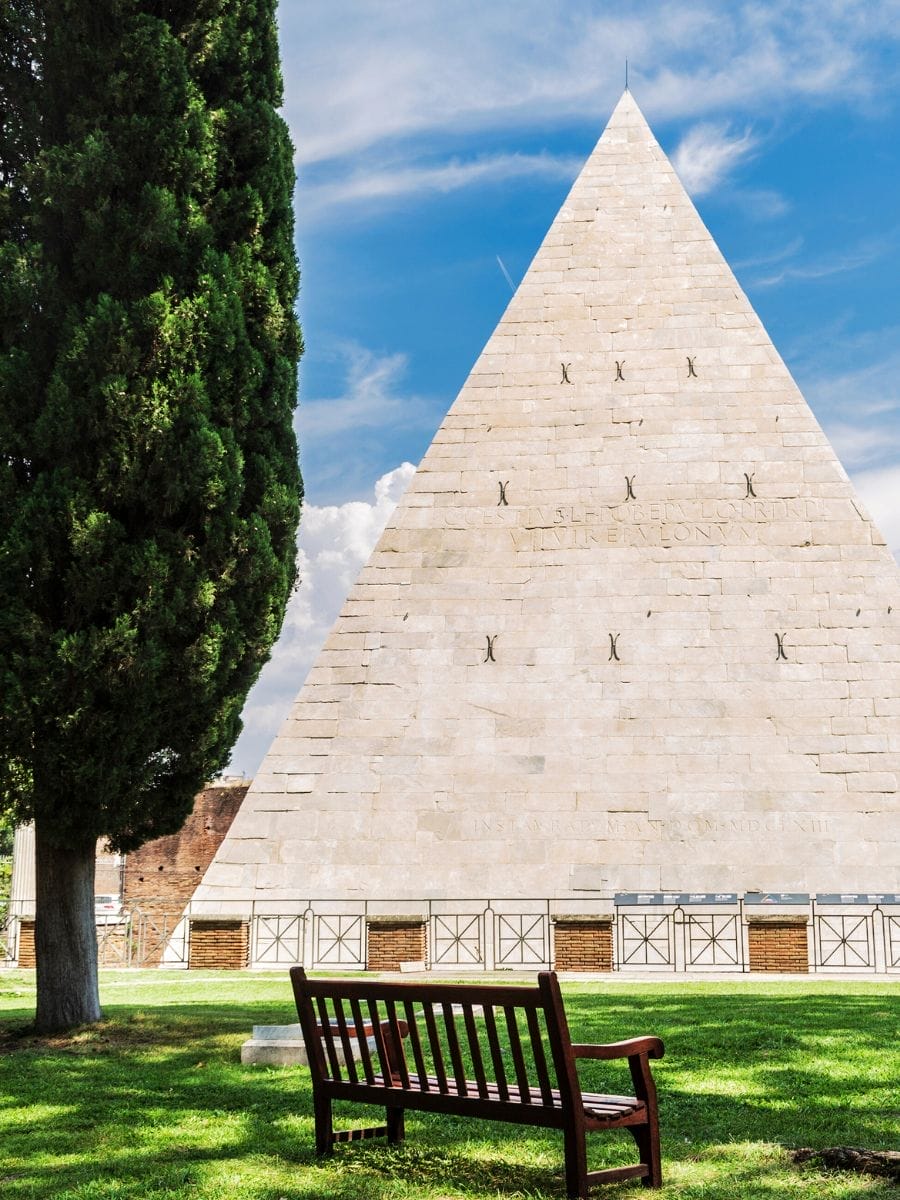
Views from Aventine Hill: The Most Beautiful Panoramas
One of the great pleasures of climbing Aventine Hill in Rome is seeing the city from a completely different angle. No high platforms like the Janiculum, no long queues like at the Vittoriano… just soft, poetic panoramas that unfold quietly in front of you.
View of St. Peter’s, the Tiber, and Trastevere
From the Orange Garden, the view over Rome is one of the most beautiful in the city. Not the highest, not the most dramatic… but perhaps the most harmonious view.
Right in front of you, the dome of St. Peter’s Basilica rises perfectly centered. Depending on the light, it can look golden, bright white, or slightly silver. The Tiber winds silently below, while the rooftops of Trastevere stack up like layers of watercolor.
What makes this view so special is its balance:
- the garden’s trees frame the horizon
- the river adds depth
- the domes and ochre buildings create a soft, warm palette
- and the shifting light transforms the entire scene throughout the day
Tip : Come early in the morning and the city is still quiet. In late afternoon, everything warms up, domes, facades, bricks, terracotta tiles… all turn golden. And when the sun sets behind the Janiculum Hill, the silhouette of St. Peter’s becomes almost unreal. It’s the kind of place where you can sit for 20 minutes without noticing time passing.
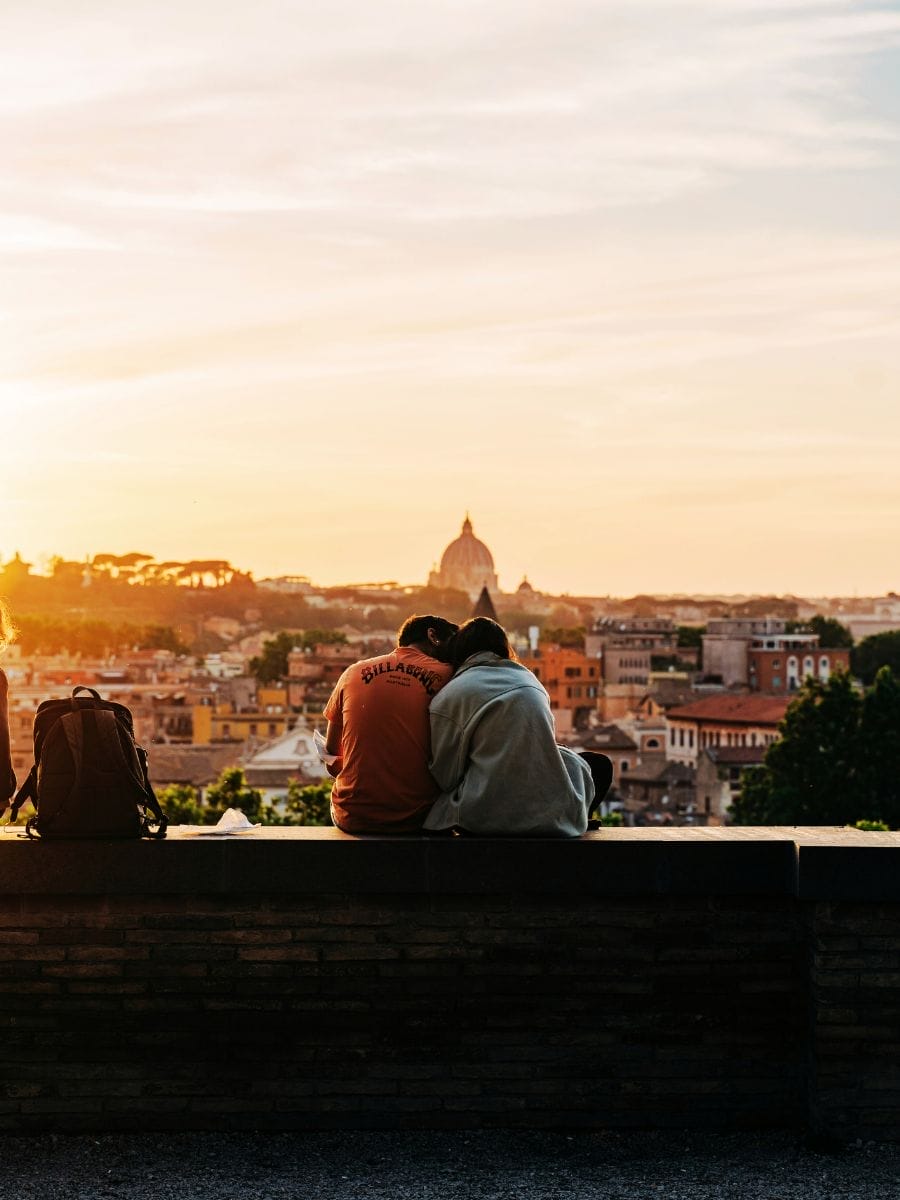
Panorama of the Circus Maximus and the Palatine Hill
On the other side of the hill, just a short walk down the eastern slope, another panorama awaits, a sweeping view over the Circus Maximus and the monumental ruins of the Palatine Hill. It’s a completely different perspective from the Orange Garden: grander, more dramatic, and steeped in history.
The Circus Maximus, once the vast arena for chariot races, appears below as a long strip of green. Behind it, the remains of the Palatine rise with their towering walls, arches, and suspended terraces. These are the vestiges of the Domus Augustana, the immense imperial palace built by Emperor Domitian in the 1st century.
In the evening light, the ruins take on a warm, pinkish glow. Arrive around sunset and you’ll watch the stones slowly light up, as if the emperors were reclaiming their palaces. The atmosphere is magical and yet, astonishingly, there are very few people here.
It’s the perfect spot if you want to:
- take stunning photos of the Palatine
- admire a peaceful sunset without the crowds
- enjoy a quiet moment before heading back down toward Testaccio or Circo Massimo
Practical Information for Visiting Aventine Hill in Rome
Planning to discover Aventine Hill in Rome during your trip? Excellent idea. Here’s everything you need to know to organize your visit easily and make the most of your time on the hill.
Where Is Aventine Hill in Rome?
Aventine Hill is located just south of Rome’s historic center, above the Circus Maximus and along the River Tiber.
It is framed by Palatine Hill to the north, Caelian Hill to the east, Testaccio to the south and the Tiber River to the west
- Address : Piazza dei Cavalieri di Malta, 00153 Rome, Italy
To find it easily
- Facing the Circus Maximus: Aventine Hill rises just behind you, toward the Tiber.
- From the Colosseum: Walk toward the Circus Maximus; the Aventine begins right at the far end of the ancient racetrack.
- From Testaccio: Use the Pyramid of Cestius as your landmark, the hill begins just five minutes from there.
How to Get to Aventine Hill in Rome
The good news is that Aventine Hill is very easy to reach, no matter where you’re staying in the city. Here are the simplest options using Rome’s public transport system.
- By Metro (fastest option) : Take Line B and get off at Circo Massimo → best if you want to walk up via the Rose Garden or the Orange Garden or Piramide → ideal if you want to visit the Pyramid of Cestius + the Protestant Cemetery before heading up. From Circo Massimo, it’s a 10–15 minute walk along the Circus Maximus — an easy and pleasant uphill stroll.
- By Bus : Perfect if you’re staying near the Vatican, Trastevere, or along the Tiber. Recommended lines: 23, 30, 81, 628. Get off at Aventino, Santa Prisca, or Piramide, all within a 5-minute walk of the churches and the Aventine Keyhole.
- By Tram : Tram line 3 stops at Aventino and Piramide. It’s convenient, inexpensive, and perfect if you're coming from Trastevere or San Giovanni.
- On Foot : One of the biggest advantages of Mount Aventine is how close it is to everything. Walking time from the Colosseum → 20 minutes (1.5 km), from the Roman Forum → 15 minutes, from Circus Maximus → 5 minutes, from Testaccio → 10 minutes. The climb is gentle, and the walk is genuinely beautiful, especially if you go through the Rome Rose Garden (open May to October).
- By Car (not recommended) : Although Aventine Hill is not officially listed as a ZTL (Limited Traffic Zone), several streets leading to the hill border or cross ZTL areas. It’s very easy to take a wrong turn and receive a fine. If you’re driving in Rome, it’s much safer (and more pleasant) to park elsewhere and continue on foot or by public transport.
How Much Time Do You Need to Visit Aventine Hill?
Good news: Aventine Hill in Rome is very easy to visit, whether you have just 30 minutes or half a day. It all depends on how much time you want to spend in the gardens and churches.
👉 Quick visit (30–45 minutes) : Perfect if you want the essentials. Walk up the hill, take a look through the Aventine Keyhole (5–10 minutes), enjoy the view from the Orange Garden (about 20 minutes), peek into Santa Sabina if it’s open, then head back down. Simple, efficient, beautiful.
👉 Full visit (1.5 to 2 hours) : The ideal pace to explore the Aventine without rushing. Add Santa Sabina, Sant’Alessio, a stroll through the quiet residential streets, and possibly Santa Prisca if it’s open.
👉 In-depth visit (3 hours to half a day) : If you want to explore the foot of the hill as well, plan a bit more time. You can walk through the Rome Rose Garden (May–October), visit the Protestant Cemetery, see the Pyramid of Cestius, end your visit in Testaccio with a drink or a plate of pasta
It’s one of the most beautiful “off the beaten path” itineraries just outside Rome’s historic center.
Safety and Atmosphere on Aventine Hill
The Aventine is one of the safest and most residential neighborhoods in Rome. You can walk around at any time of day without any concern.
A few helpful notes:
- The streets are incredibly quiet, surprisingly so for an area this close to the center.
- The neighborhood is filled with elegant villas, small period buildings, and religious institutions. It feels nothing like the busier tourist zones.
- In the evening, the atmosphere is soft, intimate, almost silent, ideal if you want a break from the crowds.
- Around Circus Maximus or Piramide, it’s a bit livelier, but still completely safe.
Where to Eat and Have a Drink Near Aventine Hill
There aren’t many restaurants on Aventine Hill itself — it’s a residential and institutional neighborhood.
But just around the hill, you’ll find some of the best areas in Rome for great food and a relaxed drink.
Testaccio (5–10 minutes on foot)
If you’re looking for real Roman cuisine in a local atmosphere, Testaccio is the place to go. It’s one of Rome’s most authentic dining districts, loved by locals for its traditional dishes, wine bars, and lively evenings.
A few excellent options :
- Felice a Testaccio : Famous for its legendary cacio e pepe, mixed directly at the table.
- Trapizzino : Perfect for tasting Roman street food, the iconic “trapizzino” pocket filled with classic Roman recipes.
- La Fraschetta di Mastro Giorgio : A great spot for incredible charcuterie boards, cheeses, and rustic Roman specialties.
For a drink:
- L’Oasi della Birra : Half wine bar, half bottle shop, cozy, friendly, and a favorite for aperitivo.
- Sacripante Art Gallery Bar : A stylish mix between an art gallery and a cocktail bar, very atmospheric.
Viale Aventino (at the foot of the hill)
At the base of the Aventine, Viale Aventino is lined with cafés, bakeries, and casual restaurants, ideal if you want something close and easy after your visit.
Places worth stopping by:
- CasaManfredi : An excellent pâtisserie and café, perfect for a cappuccino, italian coffee, pastries, or a light break.
- Tigelleria Romana : A great option for a quick snack inspired by Italian tigelle, small, warm flatbreads filled with cheeses, cold cuts, or spreads.

A Brief History of Aventine Hill
One of the Seven Hills of Rome
Aventine Hill is one of the legendary Seven Hills of Rome, rising just south of the historic center between the Tiber, the Palatine Hill, and the Caelian Hill. Certain slopes, especially those facing the river, are surprisingly steep, and the hill reaches a height of 46.6 meters.
It’s often described as the most “isolated” of Rome’s seven hills, and that’s true: the Aventine has always been a little apart, a little different.
The hill is actually divided into two distinct areas:
- The Greater Aventine, the part most visitors know, home to the gardens, the churches, and the famous Aventine Keyhole.
- The Lesser Aventine (Piccolo Aventino), more residential and discreet, where you’ll find the basilica of San Saba.
In ancient Rome, the Aventine wasn’t included in the pomerium, the sacred boundary of the city. Because of that, the hill was settled much later than the Palatine or Capitoline Hill.
It wasn’t until Emperor Claudius, in the 1st century AD, that the Aventine was officially incorporated into Rome’s sacred perimeter, a change that finally allowed the area to grow, gain importance, and develop prestige.
Romulus, Remus, and the Origin of the Name
If you enjoy legends, you’ll love this.
The name Aventine (Aventino in Italian) may come from Aventinus, the son of Hercules and the priestess Rhea. He later became king of Alba Longa, an ancient city in the Latium region, and is said to have made the hill his domain.
Another myth, even more famous, claims that Remus, twin brother of Romulus, wanted to found Rome on the Aventine. Romulus, on the other hand, preferred the Palatine Hill. The gods sided with Romulus, the city was founded on the Palatine… and the rest is history.
Remus, according to some versions, was buried on the Aventine.
This divine rivalry has always given Mount Aventine a slightly rebellious, outsider character, which is why the hill became a symbol of protest and political dissent in Roman history.
In Roman Republican times, the plebeians would literally retreat to the Aventine to protest against the Senate and assert their rights. The hill was a symbol of disagreement and resistance.
From “Cursed Hill” to Elegant Neighborhood
For centuries, the Aventine was considered a “cursed hill.” Not in a frightening sense, but simply ignored, overlooked, left on the margins. The Romans didn’t urbanize it before the 1st century AD. It was too far from the center, too exposed, and not sufficiently sacred in the eyes of Roman religion.
Everything changed when Emperor Claudius brought the hill within the city walls.
From that moment, the Aventine became habitable and slowly began to attract residents. Emperors Caracalla and Decius even built thermal baths here in the 3rd century, a sign of the area’s growing importance.
Over time, the population evolved:
- first inhabited by the plebeians,
- then abandoned when the plebs moved to Trastevere,
- and finally reoccupied by aristocratic families during the Imperial era.
This layering of stories, social classes, and centuries of reconstruction is what gives the Aventine its unique charm today: a peaceful, elegant, leafy hill where every stone still whispers a little piece of Rome’s past.
What to See Near Aventine Hill
Aventine Hill sits in one of the richest cultural areas of Rome. Once you’ve enjoyed the peaceful atmosphere at the top, you can easily continue your day by exploring several major landmarks just a short walk away.
Here are 7 unmissable places to visit near Monte Aventino:
- Circus Maximus : Right at the foot of Aventine Hill, this vast ancient hippodrome once held up to 250,000 spectators during chariot races. Today it’s an open park where locals stroll, relax on the grass, and admire the Palatine Hill directly in front of them. A perfect transitional stop after the Aventine.
- Palatine Hill : A few minutes away, the Palatine is the legendary birthplace of Rome. You can explore the monumental ruins of the imperial palaces, wander through the Farnese Gardens, and enjoy sweeping views over the Roman Forum. It’s one of the city’s most important archaeological areas and a beautiful complement to the Aventine.
- Testaccio District : South of the Aventine, Testaccio is a lively and authentic neighborhood known for its traditional trattorias, vibrant market, and wine bars. With its real Roman atmosphere and great food options, it’s one of the best places to eat after your visit to Aventine Hill.
- Monte Testaccio : This unusual artificial hill is made entirely of broken amphorae discarded between antiquity and the Middle Ages. Although not always open to visitors, it can be admired from outside, and many nearby bars and restaurants share its fascinating history. A curious and unexpected sight near the Aventine.
- Basilica of San Saba : Located on the Lesser Aventine, San Saba is a small Romanesque basilica built over an early monastic settlement. Quiet, understated, and often overlooked, it has a peaceful courtyard and a serene interior that make it a perfect hidden gem for church lovers.
- Caelian Hill (Celio) : This neighboring hill is ideal if you enjoy calm, green spaces. You can visit the atmospheric Basilica of Santi Quattro Coronati or explore the Case Romane del Celio, a set of ancient Roman houses filled with beautifully preserved frescoes. A quiet, enriching extension to your walk.
- Baths of Caracalla : Less than ten minutes away, the massive Baths of Caracalla are among the largest and best-preserved thermal complexes from the Roman Empire. Their towering walls and gardens offer a striking glimpse into ancient public baths. A spectacular site that pairs perfectly with a visit to Aventine Hill.
FAQ About the Aventine Hill in Rome

Is Aventine Hill free to visit?
Yes, entirely free. You can walk around the neighborhood, visit most of the churches, enjoy the view from the Orange Garden, and look through the famous keyhole without paying anything. It’s one of the rare places in Rome where all the highlights are accessible at no cost.
Can you enter the garden behind the keyhole?
No, the garden of the Priory of the Knights of Malta is not open to the public. The large green door always remains closed, and the only way to glimpse the cypress-lined path and the dome of St. Peter’s Basilica is through the keyhole.
Is the Orange Garden open all year?
Yes, the Orange Garden is open year-round, with hours that change according to the season. In winter, it usually closes in the late afternoon, while in summer it stays open until early evening. It is a public space maintained by the city and does not have seasonal closures.
What is the difference between Aventine Hill and the Lesser Aventine?
“Aventine Hill” generally refers to the main section of the hill, where you’ll find the Orange Garden, Santa Sabina, Sant’Alessio, and the Piazza dei Cavalieri di Malta with the keyhole.
The “Lesser Aventine” is a separate, more residential area on the eastern side of the hill. It is quieter and more secluded, home to the Basilica of San Saba. Both areas are close to each other, but the main Aventine concentrates nearly all the tourist attractions, while the Lesser Aventine feels like a small village hidden within Rome.
Can you visit Aventine Hill in the evening?
Yes, absolutely. The Aventine is a peaceful, very safe residential neighborhood, perfect for an evening walk.
The churches close in late afternoon, but you can still enjoy the quiet streets, admire the nighttime cityscape from the Orange Garden, and even check the keyhole after dark. The paths are well lit, and the area around Circus Maximus remains active.
Is the Aventine a good area to stay in Rome?
Yes, it’s an excellent choice if you want a calm, elegant, and safe area close to the center. Accommodation is limited but generally high-quality, with charming guesthouses and a few boutique hotels.
It’s ideal if you prefer to avoid busy tourist districts like Trastevere or the historic center while still being within walking distance of the Colosseum and Circus Maximus.
Can you access the Rose Garden in winter?
No, the Municipal Rose Garden of Rome is not open in winter. It only opens from May to October during the blooming season.
Outside these months, the gates remain closed. If you visit Rome in spring or early summer, it’s a beautiful way to walk up toward Aventine Hill surrounded by more than a thousand varieties of roses.
Fanny is a music and travel lover who has been visiting Rome since 2012. She is the founder and main editor of the Roma Pass blog and she like to share the best things to do in Rome.
